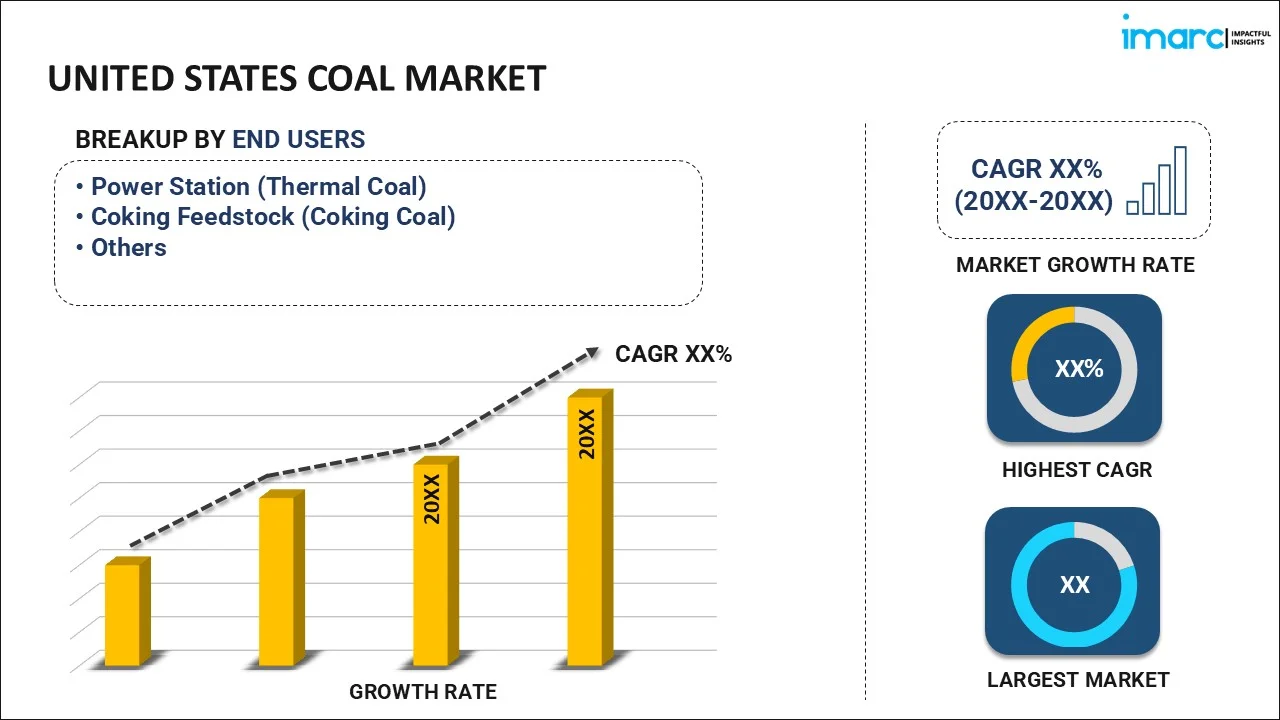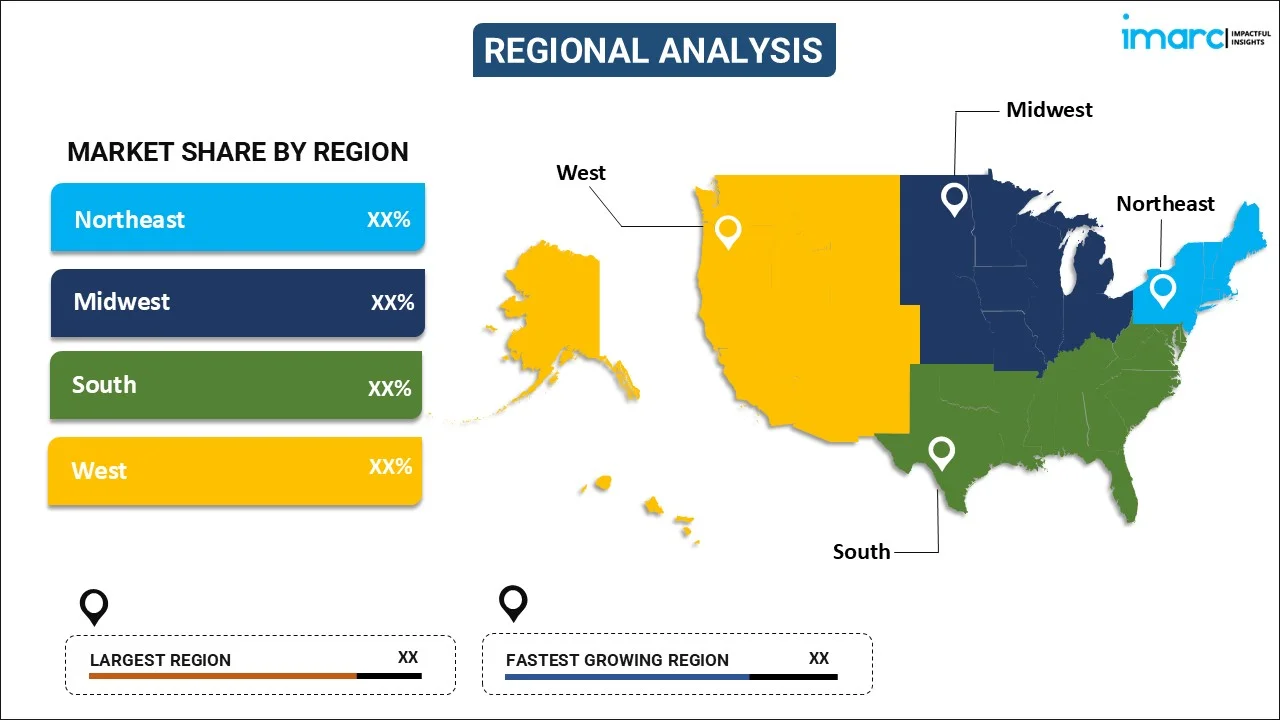
United States Coal Market Size, Share, Trends and Forecast by End User, and Region, 2025-2033
United States Coal Market Size and Share:
The United States coal market size reached USD 68.30 Billion in 2024. Looking forward, IMARC Group expects the market to reach USD 74.10 Billion by 2033, exhibiting a growth rate (CAGR) of 0.80% during 2025-2033. The rising demand for electricity, cost-competitiveness of coal in energy generation, expanding exports to Asia, increasing demand for metallurgical coal in steelmaking, government policies supporting coal production, and ongoing technological advancements in cleaner coal technologies are some of the key factors strengthening the market growth.
|
Report Attribute
|
Key Statistics
|
|---|---|
|
Base Year
|
2024
|
|
Forecast Years
|
2025-2033
|
|
Historical Years
|
2019-2024
|
| Market Size in 2024 | USD 68.30 Billion |
| Market Forecast in 2033 | USD 74.10 Billion |
| Market Growth Rate (2025-2033) | 0.80% |
United States Coal Market Analysis:
- Major Market Drivers: United States Coal Market analysis indicates that demand is driven mostly by stable electricity supply and industrial power requirements. Domestic availability in abundance, low costs, and favorable policies by the government remain United States Coal Market growth drivers despite the implementation of renewable energy.
- Key Market Trends: Key developments are the use of cleaner coal technology, including high-efficiency, low-emission facilities, and carbon capture. Growing utilization of coal in metallurgical processes and strategic blending with sophisticated logistics solutions are characterizing the development of the United States coal market.
- Competitive Landscape: Dominant producers rule the United States coal market, emphasizing operational efficiency, sustainability, and technology improvements. Powerful logistics channels, local presence in mining, and extended supply agreements reinforce market standing, with the United States coal market demand remaining robust across the electricity generation and industries.
- Challenges and Opportunities: Challenges are posed by environmental laws, competition from renewable energy, and the pressure to reduce emissions from the general public. Opportunities exist in metallurgical coal exports, retrofitting with cleaner technology, and utilizing domestic coal for energy security, which offers potential for expansion in the United States coal market.
United States Coal Market Trends:
Rising demand for metallurgical coal
One of the main trends sustaining the United States coal market growth is the rising demand for metallurgical coal, which plays an important role in steel manufacturing. Metallurgical coal or coking coal plays a vital role as an input in the blast furnace method of steel production. Moreover, the U.S. steel industry remains one of the biggest consumers of metallurgical coal despite competition from cheaper imports. Besides this, the surge in international demand for U.S. metallurgical coal, especially from Asia on account of the strong industrial activity in emerging economies such as China and India is driving the market growth. For instance, international coal trade volumes are anticipated to hit an all-time high of 1.55 billion tons in 2024. This surge is largely attributed to increased demand from Asian countries, with China and India leading in import volumes. Such nations are increasing their capacities for steel production to help drive infrastructure projects and manufacturing expansion, thereby promoting imports of high-quality U.S. metallurgical coal that is impelling the United States coal market share.
Shift towards cleaner coal technologies
The other major trend in the American coal industry is the use of cleaner coal technologies. Due to increased anxiety over pollution of the environment and global warming, the coal sector is being compelled to lower its carbon footprint. Consequently, there has been heavy investment in clean coal technologies like carbon capture and storage (CCS), integrated gasification combined cycle (IGCC), and ultra-supercritical (USC) steam cycles. These technologies seek to reduce greenhouse gas (GHG) emissions while enhancing the efficiency of coal power plants. Along with this, the U.S. government has been encouraging the development and use of these technologies through numerous policies and subsidies to make coal a competitive energy source in a carbon-constrained world, thus fueling United States coal market growth. For example, in October 2024, the U.S. government awarded $428 million in grants to support clean energy projects in regions historically dependent on coal mining and coal-fired power plants. These grants aim to revitalize local economies and facilitate a transition to cleaner energy sources. Furthermore, the increasing demand to meet strict environmental regulations at home and abroad is boosting the U.S. coal market share.
Expanding export markets
The U.S. coal market outlook is widely influenced by the expansion of export markets, particularly in Asia and Europe. U.S. coal producers have been capitalizing on the growing demand for both thermal and metallurgical coal in these regions. According to International Energy Agency (IEA) 2025 reports, in June 2024, U.S. coal exports reached 10 million short tons, the highest monthly volume since October 2018. Moreover, in Asia, countries like China, India, and South Korea import U.S. coal due to their expanding industrial base and the need to diversify energy sources. Europe still needs US coal even with its commitment to lowering carbon emissions, particularly during times of high energy consumption or when other energy sources are not enough. This trend counteracts the country's declining coal consumption, as more people turn to natural gas and renewable energy sources to generate electricity, creating a positive outlook for market growth. Furthermore, the growth of port infrastructure and logistics capabilities in the United States facilitates the efficient transportation of substantial amounts of coal-by-coal producers to foreign locations, thereby contributing to the expansion of export markets.
United States Coal Market Segmentation:
IMARC Group provides an analysis of the key trends in each segment of the market, along with forecasts at the region level for 2025-2033. Our report has categorized the market based on end user.
End User Insights:

To get more information on this market, Request Sample
- Power Station (Thermal Coal)
- Coking Feedstock (Coking Coal)
- Others
The report has provided a detailed breakup and analysis of the market based on the end user. This includes power station (thermal coal), coking feedstock (coking coal), and others.
Regional Insights:

- Northeast
- Midwest
- South
- West
The report has also provided a comprehensive analysis of all the major regional markets, which include Northeast, Midwest, South, and West.
Competitive Landscape:
The market research report has also provided a comprehensive analysis of the competitive landscape. Competitive analysis such as market structure, key player positioning, top winning strategies, competitive dashboard, and company evaluation quadrant has been covered in the report. Also, detailed profiles of all major companies have been provided.
United States Coal Market News:
- In August 2025, The Trump administration greenlit four new coal permits, Tennessee's Hurricane Creek Mining and Montana's Rosebud Mine, reclassified coal as a mineral, and reopened federal lands. These steps are designed to reduce permitting, increase U.S. coal production and exports, and enhance domestic energy security and competitiveness.
- In August 2024, CONSOL Energy and Arch Resources completed an all-stock merger to form Core Natural Resources, a leading North American coal producer. With a total value of \\$5.2 billion, the firm will control 11 mines in six states and produce high-quality thermal and metallurgical coal, with strategic access to U.S. East Coast, West Coast, and Gulf export terminals.
United States Coal Market Report Coverage:
| Report Features | Details |
|---|---|
| Base Year of the Analysis | 2024 |
| Historical Period | 2019-2024 |
| Forecast Period | 2025-2033 |
| Units | Billion USD |
| Scope of the Report |
Exploration of Historical Trends and Market Outlook, Industry Catalysts and Challenges, Segment-Wise Historical and Future Market Assessment:
|
| End User Covered | Power Station (Thermal Coal), Coking Feedstock (Coking Coal), Others |
| Regions Covered | Northeast, Midwest, South, West |
| Customization Scope | 10% Free Customization |
| Post-Sale Analyst Support | 10-12 Weeks |
| Delivery Format | PDF and Excel through Email (We can also provide the editable version of the report in PPT/Word format on special request) |
Key Benefits for Stakeholders:
- IMARC’s industry report offers a comprehensive quantitative analysis of various market segments, historical and current market trends, market forecasts, and dynamics of the United States coal market from 2019-2033.
- The research report provides the latest information on the market drivers, challenges, and opportunities in the United States coal market.
- Porter's five forces analysis assist stakeholders in assessing the impact of new entrants, competitive rivalry, supplier power, buyer power, and the threat of substitution. It helps stakeholders to analyze the level of competition within the United States coal industry and its attractiveness.
- Competitive landscape allows stakeholders to understand their competitive environment and provides an insight into the current positions of key players in the market.
Key Questions Answered in This Report
The coal market in the United States was valued at USD 68.30 Billion in 2024.
The United States coal market is projected to exhibit a (CAGR) of 0.80% during 2025-2033, reaching a value of USD 74.10 Billion by 2033.
The market is largely fueled by the demand for secure electricity supply and industrial energy supply. Plentiful indigenous reserves, cost-effectiveness, and the support of energy security by the government keep demand going. The demand for metallurgical coal for steel production and infrastructure construction also plays an important role in market growth.
Need more help?
- Speak to our experienced analysts for insights on the current market scenarios.
- Include additional segments and countries to customize the report as per your requirement.
- Gain an unparalleled competitive advantage in your domain by understanding how to utilize the report and positively impacting your operations and revenue.
- For further assistance, please connect with our analysts.
 Request Customization
Request Customization
 Speak to an Analyst
Speak to an Analyst
 Request Brochure
Request Brochure
 Inquire Before Buying
Inquire Before Buying




.webp)




.webp)












